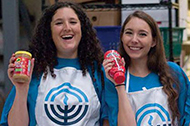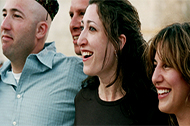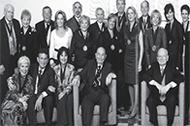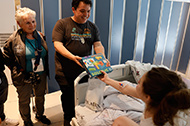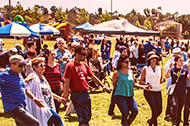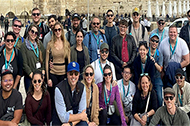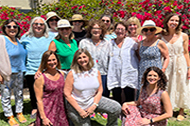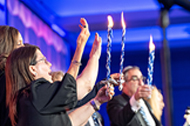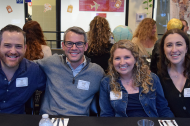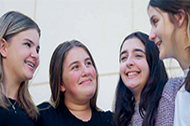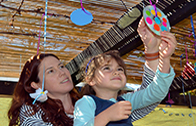April 2, 2024: Zvi Weiss
04/02/2024


Those of you who know me well know that I have a complicated relationship with the notion of God. One might say that my identity as a Jew is rooted more in Jewish peoplehood than religion. Today, I had the most spiritual experience I have had in years when I encountered Dr. Shai Efrati, the head of Shamir hospital’s Hyperbaric Center, the leading hyperbaric center in the world.
Dr. Efrati opened by sharing that every horrible situation has the potential for good because bad situations force one to be creative and work fast to find a solution. The horrors of October 7th have forced Dr. Efrati and his team to do just that as they have been faced with unprecedented injuries in both military and civilian populations. Whereas most medical treatments involve either putting something into one’s body (e.g. medicine) and/or physically changing one’s body (e.g. surgery), hyperbaric treatments focus on changing the environment surrounding ones body (e.g. pressure, oxygen) so as to impact things such as blood flow and oxygen levels. These and related treatments are administered in tanks that look to me like a cross between a subway car and a submarine. While these types of treatments are typically used to treat cases of smoke inhalation, Dr. Efrati has successfully used this incredible treatment to reduce the need for amputations in injured soldiers by some 80%, even in unprecedented cases of soldiers suffering from fungal infections resulting from Gaza’s lack of sewage treatment. He has even begun using a similar approach with great success for the treatment of severe PTSD, currently repairing brain tissue anomalies identified in MRI’s for 350 patients. What moved me to tears was Dr. Efrati’s approach to his field. When he looks into the eyes of a soldier he commits that he will never let that soldier die, and to his credit, he never has. So many soldiers and civilians in this war owe their lives to his creativity and determination. If ever there were an angel in human form, it is Dr. Efrati.
From one angel, we visited another team of angels at the Schneider Children’s Hospital in Petach Tikvah. The 500-bed hospital has a foundation that focuses on the emotional wellness of its patients, through providing child-friendly experiences such as crafts, clowns, support animals and even flight simulator training provided by volunteer El Al pilots. We were privileged to gift toys to patients in one of the wards. This foundation was co-founded by a former San Diegan, Iris Langer, with whom I went to college, and who I was told sent her children to the Academy. Iris suffered a terrible burn accident as a young child when a menorah fell on her clothes. Her memories of the challenges of her own extended hospital stays inspired her establishment of the foundation. The second half of our visit focused on the hospital’s role in the absorption and rehabilitation of freed child hostages. There is no research or guidelines on how to receive children who have been held captive, so using all of their resources they created protocols and were there to receive each and every child hostage and their family. Once again, I found myself in tears as I watched a video of their arrival at the hospital.

At lunch at the Levinski spice market, I met recent SDJA graduate Eduardo Poupko, who is spending a gap year in Israel, preparing for his Marva IDF experience. Eduardo and I were reminiscing about our meet up in Sha’ar HaNegev last year when he was on the senior trip, as he shared some of his experiences this year. Eduardo deferred admissions from Indiana University for this year and is now contemplating staying in Israel. I couldn’t be more proud of Eduardo’s intellect, maturity, and strong Jewish identity.

After lunch, we continued to Hostage square, the transformed plaza in front of the Tel Aviv Museum. There amidst art installations that beckon us to not forget the 134 men women and children still held hostages, we are encouraged to continue doing everything in our power to bring about their release. The art installation of the Shabbat table with empty seats has been transformed, with half of the table set beautifully to represent those released, and the other half set in a way that echoes the harsh condition in which they are being held captive, with little water and occasional bits of pita. I was moved by the many visitors who joined hostage families sitting in tents, and bought dog tags and pins, the proceeds of which support the efforts of the hostage families.
We spent the evening at Kibbutz Shefayim, the main hub of life for Kibbutz Kfar Aza, one of the kibbutzim that suffered the greatest loss during the war, with nearly 70 of its residents murdered on that day and five of its residents still held hostage. We heard from Vered Lifshitz, widow of Mayor Ofir Lifshitz who was murdered on October 7th about the many challenges facing the evacuees; she herself lives in a rented house in an adjacent community and commutes to the kibbutz Shefayim hotel daily, as do others who have chosen to live “off campus” since the kibbutz is where the schools are as well as all social services and community. We also met her friend Mazzi, whose husband Tal was chief of security, also murdered during the first hours of October 7th. Mazzi and her three children were lucky to be selected to live in one of 50 modular units that were put up in the hotel’s parking lot.
While the tight quarters are a challenge, they do not compare to the challenges faced by Bosmat, one of the teens that we met who had just been part of the delegation to SDJA. Her family was relegated to a small hotel room where there is no privacy nor personal space. Vered shared that while her older son is anxious to return to Kfar Aza, her younger son declared that he is not interested in returning at this time, so Vered herself began an initiative to have the residents relocated to a modular village, to be erected next to Kibbutz Ruhama. This will be close to their real homes, which they could hopefully re-occupy in two years.
At dinner I walked by a table with five empty chairs, one for each of the Kfar Aza residents still held in captivity. I had the chance to catch up with another couple of recent visitors to SDJA, who were also continuing to glow from their visit. I didn’t remember their names, but I remembered their faces, and we hugged as reunited relatives. After dinner, we spent some time at the Pub, a replica of “Pubooshka,” Kfar Aza’s Pub – which was built to specification by volunteers from Kibbutz Shefayim. I sat with new friends, Orly and Israel. Orly is a retired social worker who had visited SDJA as part of a professional delegation many years ago, and Israel is an electrician who had a handyman company that serviced Kfar Aza for over 30 years. Once again I heard a terrifying story of 34 hours in the dark, holding the door to their safe room closed as terrorists rummaged through their home and assumed a position on their roof from where they fired on the row of young adult housing right below. They had entered their safe room without a phone, so they had no contact with the outside world, and they were assumed dead. Israel visits Kfar Aza every week, and longs for their return. Israel then shared a photo with me of Kfar Aza’s soccer team which his company had sponsored and which had won the past year’s championship. Of the 16 men in the photo, only two had not been directly affected by the events of October 7th. Three in the photo had been murdered, two were currently hostages in Gaza, several had lost parents and siblings, including one who was the brother of one of the hostages who escaped and was mistakenly shot by the IDF. This smiling band of brothers no more.
As I once again approach the 2AM mark, I will sign off for the night, hurting for the hostages, grieving for the loss and injury, inspired by the ingenuity, compassion and resilience that I witnessed today, while preparing myself for yet another full day of bearing witness and showing support for our extended family in the south tomorrow. Am Yisrael Chai!
